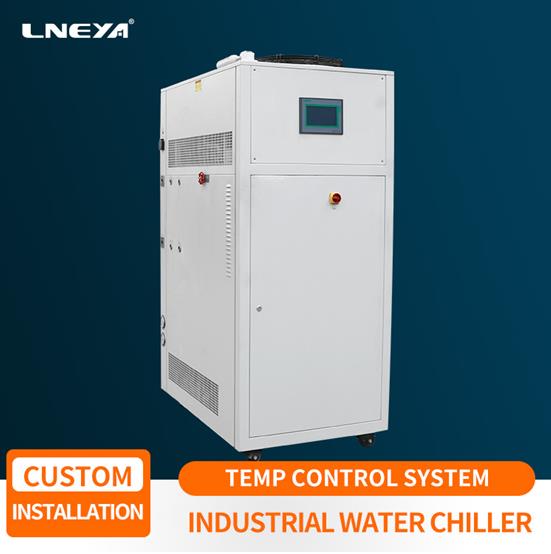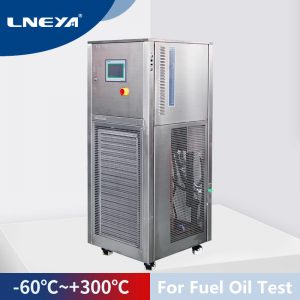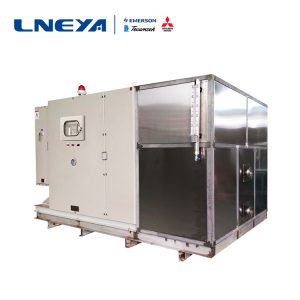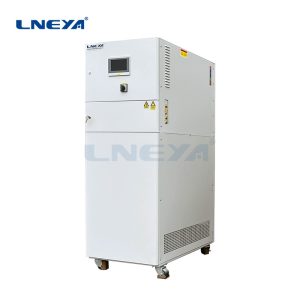Description of the principle and mode of industrial water chiller refrigeration cycle
Anyone who knows about industrial water
chillers should know that it uses compressors to achieve the cooling effect.
So, how does it work when refrigerating?

1. Vapor compression refrigeration cycle.
After cooling and pressurizing the vapor
from the evaporator, it is recondensed into a liquid, and then evaporated
again, so that it continues to circulate, which is the vapor compression
refrigeration cycle. Industrial water chillers adopt this refrigeration method,
and the principle of vapor compression refrigeration cycle is realized in this
way.
Fill the industrial water chiller with the
refrigeration medium in a sealed system. After the liquid working fluid is
throttled and depressurized by the throttling device, it will vaporize and
absorb heat at the middle pressure in the evaporator to become low-temperature
and low-pressure steam, and then pass through the compressor. Adiabatic
compression into high temperature and high pressure steam, liquefaction in the
condenser to release heat, and then enter the throttling device, thus
completing a refrigeration cycle.
2. Absorption refrigeration cycle.
The absorption refrigeration cycle utilizes
the heat energy provided by the heat source to make the working medium
circulate. Its working principle is as follows: it replaces the compressor with
components such as absorber and generator, and uses two working mediums. The
working medium with low boiling point is called refrigerant The high boiling
point working fluid is called absorbent, and the functions and principles of
other components are basically the same as the vapor compression refrigeration
cycle.
There are two loops in the absorption
refrigeration cycle of industrial water chillers. Its working process is: after
the liquid refrigerant is throttled and reduced by the throttling device, it
evaporates and absorbs heat at the middle pressure in the evaporator and
becomes low-pressure, low-temperature refrigerant vapor. After entering the
absorber, it is strongly absorbed by the absorbent to form a high-concentration
refrigerant solution and release heat of dissolution. Then the refrigerant
solution in the equipment is pumped into the generator, heated by the heat
source to produce high-pressure refrigerant vapor, which is sent to the
condenser to be condensed into liquid refrigerant, and the remaining dilute
solution in the generator is decompressed Back to the absorber.
Riassumere
Wuxi Guanya (LNEYA) adopts environmentally
friendly refrigerants for the refrigeration operation of industrial water
chillers, in an environmentally friendly environment, in line with the
development theme of the current environment. Global consulting sales@lneya.com
Raccomandazioni correlate
-
Istruzioni per l'uso del sistema di circolazione secondaria dell'olio di trasferimento del calore
916Il sistema di circolazione secondaria dell'olio termico è dotato di vari strumenti e apparecchiature per il controllo della temperatura. Quando lo si utilizza, è necessario prestare attenzione alle sue conoscenze in materia di sicurezza e al suo funzionamento più sicuro. Il sistema di circolazione secondaria dell'olio termico LNEYA...
Visualizza i dettagli -
LNEYA microfluidic chip test solution
1075The microfluidic chip test is a program for testing the drive control chip. The LNEYA microfluidic chip test device specializes in processing various chip tests, and has certain advantages for the development of the chip environment. In order to i...
Visualizza i dettagli -
How to judge the quality of the pipeline for electroplating waste gas treatment?
978Generally, when purchasing the electroplating waste gas treatment equipment, it is necessary to observe the appearance of the copper tube to judge. The first is to look at the color of the copper tube. According to the type of copper tube purchase...
Visualizza i dettagli -
refrigeratori criogenici per processi chimici a flusso di droga
784I refrigeratori a bassa temperatura utilizzati nei processi di chimica a flusso di farmaci (produzione continua) sono una delle apparecchiature chiave per garantire che le reazioni avvengano in condizioni di temperatura precise. La chimica di flusso è una tecnologia di produzione continua...
Visualizza i dettagli
 Refrigeratori industriali LNEYA Produttore Fornitore
Refrigeratori industriali LNEYA Produttore Fornitore














